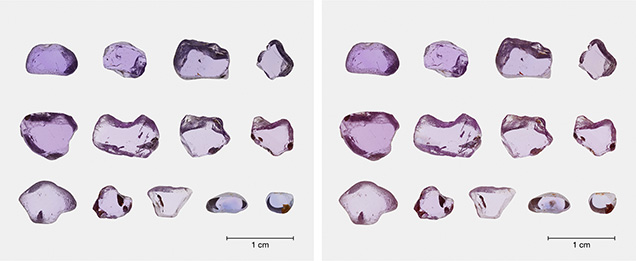The Effect of Low-Temperature Heat Treatment on Pink Sapphire

GIA has been studying low-temperature heat treatment on sapphires and rubies for the last five years. This report presents preliminary results of low-temperature heat treatment on pink sapphires, a procedure commonly used to reduce blue color components or zones. In this study, we selected 11 samples from Ilakaka, Madagascar, and one sample from Ratnapura, Sri Lanka, that were suitable for heat experiments—in other words, samples showing a 3309 cm–1 peak in FTIR with an absorption coefficient intensity of at least 0.04 cm–1 before heat treatment and fewer inclusions or fractures. From previous studies (S. Saeseaw et al., “Update on ‘low-temperature’ heat treatment of Mozambican ruby: A focus on inclusions and FTIR spectroscopy,” GIA Research & News, April 30, 2018), we know that when the 3309 cm–1 peak is high enough, the 3309 series will develop after heat treatment. While the samples’ bodycolor was predominantly pink, they all had a blue or purple modifier, as seen in figure 2 (left). Their fluorescence under UV radiation was pink, with a stronger reaction in long-wave UV than short-wave. The sapphires from Madagascar contained abundant zircon (both as single crystals and clusters), stringers of particles, short needles, growth tubes, and other minerals such as monazite. The Sri Lankan stones revealed short and long needles, fingerprints, and some single zircon crystals with tension halos.

In this experiment, the samples were heated in air at 800°C for 160 minutes. These are the minimal heating conditions for significantly reducing blue color in Mozambique rubies (Saeseaw et al., 2018). After heating, the blue component was reduced and the samples were a purer pink (figure 2, right). Their fluorescence reactions remained the same, and no chalky fluorescence was observed under short-wave UV. Most of the zircon inclusions remained unaltered, but in a few cases some small discoid fractures developed. Some of the other crystals showed tension fractures, but we noticed that only some of the mica or monazite crystals were affected by low-temperature treatment. Thus, not every stone will show clear signs of heat treatment, especially when heated only at low temperature. As reported previously, advanced techniques such as FTIR are useful in detecting heat treatment, and we applied it to these samples.
Before heating, all 12 samples exhibited a single peak at 3309 cm–1. After heat treatment, they showed a decreased 3309 cm–1 peak, while eight Madagascan and one Sri Lankan sample had developed a peak at 3232 cm–1. No 3185 cm–1 peak was detected in this experiment (see figure 2). The intensity of the peaks at 3309 and 3232 cm–1 was quite low after heat treatment; maximum intensity was only about 0.04 and 0.01 cm–1, respectively. In addition, we collected FTIR spectra on 120 unheated pink sapphires from Madagascar and 80 samples from Sri Lanka, and no 3232 cm–1 peak was detected. We concluded that the 3232 cm–1 peak is only found in heated pink sapphires.



